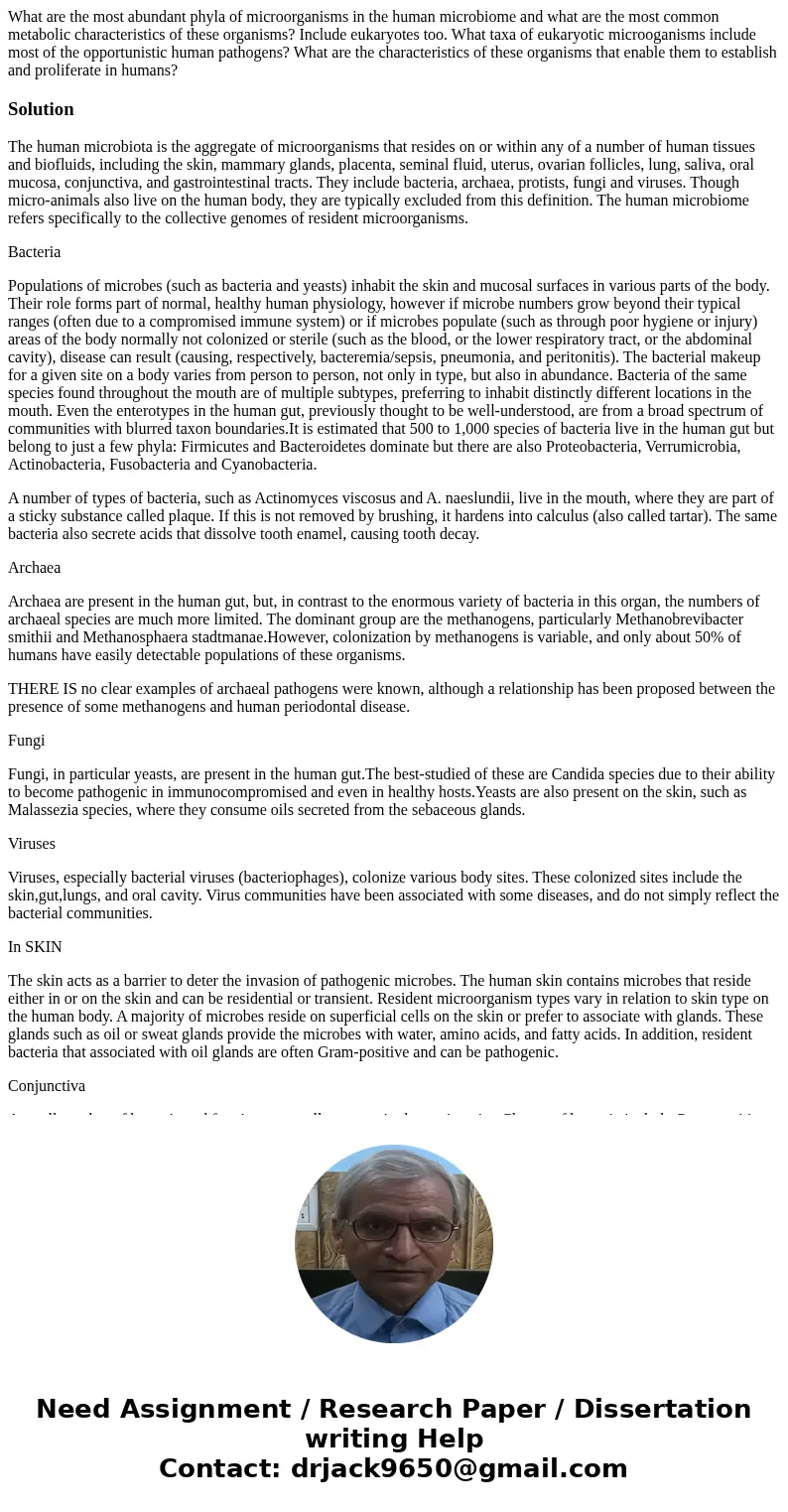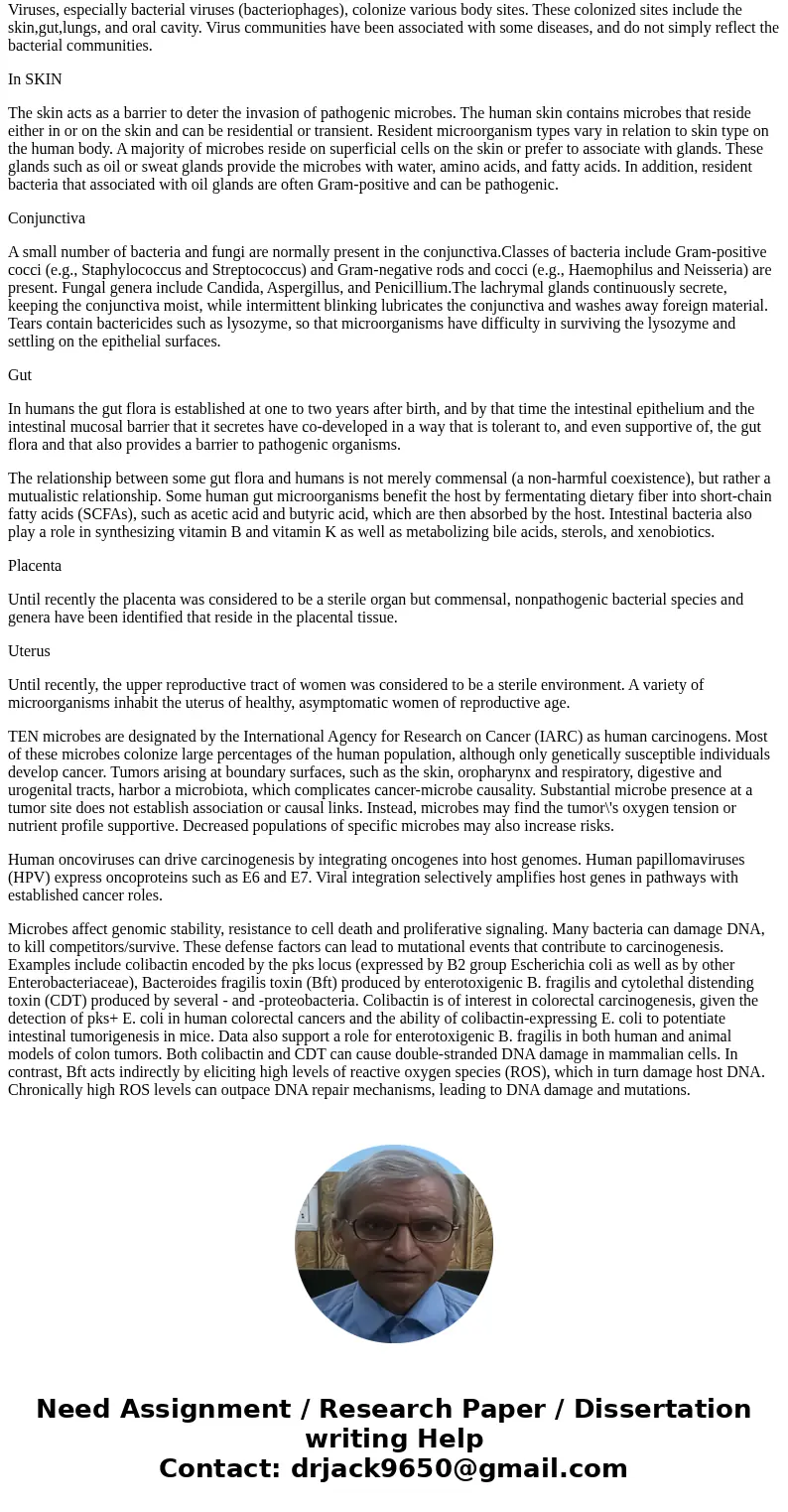What are the most abundant phyla of microorganisms in the hu
What are the most abundant phyla of microorganisms in the human microbiome and what are the most common metabolic characteristics of these organisms? Include eukaryotes too. What taxa of eukaryotic microoganisms include most of the opportunistic human pathogens? What are the characteristics of these organisms that enable them to establish and proliferate in humans?
Solution
The human microbiota is the aggregate of microorganisms that resides on or within any of a number of human tissues and biofluids, including the skin, mammary glands, placenta, seminal fluid, uterus, ovarian follicles, lung, saliva, oral mucosa, conjunctiva, and gastrointestinal tracts. They include bacteria, archaea, protists, fungi and viruses. Though micro-animals also live on the human body, they are typically excluded from this definition. The human microbiome refers specifically to the collective genomes of resident microorganisms.
Bacteria
Populations of microbes (such as bacteria and yeasts) inhabit the skin and mucosal surfaces in various parts of the body. Their role forms part of normal, healthy human physiology, however if microbe numbers grow beyond their typical ranges (often due to a compromised immune system) or if microbes populate (such as through poor hygiene or injury) areas of the body normally not colonized or sterile (such as the blood, or the lower respiratory tract, or the abdominal cavity), disease can result (causing, respectively, bacteremia/sepsis, pneumonia, and peritonitis). The bacterial makeup for a given site on a body varies from person to person, not only in type, but also in abundance. Bacteria of the same species found throughout the mouth are of multiple subtypes, preferring to inhabit distinctly different locations in the mouth. Even the enterotypes in the human gut, previously thought to be well-understood, are from a broad spectrum of communities with blurred taxon boundaries.It is estimated that 500 to 1,000 species of bacteria live in the human gut but belong to just a few phyla: Firmicutes and Bacteroidetes dominate but there are also Proteobacteria, Verrumicrobia, Actinobacteria, Fusobacteria and Cyanobacteria.
A number of types of bacteria, such as Actinomyces viscosus and A. naeslundii, live in the mouth, where they are part of a sticky substance called plaque. If this is not removed by brushing, it hardens into calculus (also called tartar). The same bacteria also secrete acids that dissolve tooth enamel, causing tooth decay.
Archaea
Archaea are present in the human gut, but, in contrast to the enormous variety of bacteria in this organ, the numbers of archaeal species are much more limited. The dominant group are the methanogens, particularly Methanobrevibacter smithii and Methanosphaera stadtmanae.However, colonization by methanogens is variable, and only about 50% of humans have easily detectable populations of these organisms.
THERE IS no clear examples of archaeal pathogens were known, although a relationship has been proposed between the presence of some methanogens and human periodontal disease.
Fungi
Fungi, in particular yeasts, are present in the human gut.The best-studied of these are Candida species due to their ability to become pathogenic in immunocompromised and even in healthy hosts.Yeasts are also present on the skin, such as Malassezia species, where they consume oils secreted from the sebaceous glands.
Viruses
Viruses, especially bacterial viruses (bacteriophages), colonize various body sites. These colonized sites include the skin,gut,lungs, and oral cavity. Virus communities have been associated with some diseases, and do not simply reflect the bacterial communities.
In SKIN
The skin acts as a barrier to deter the invasion of pathogenic microbes. The human skin contains microbes that reside either in or on the skin and can be residential or transient. Resident microorganism types vary in relation to skin type on the human body. A majority of microbes reside on superficial cells on the skin or prefer to associate with glands. These glands such as oil or sweat glands provide the microbes with water, amino acids, and fatty acids. In addition, resident bacteria that associated with oil glands are often Gram-positive and can be pathogenic.
Conjunctiva
A small number of bacteria and fungi are normally present in the conjunctiva.Classes of bacteria include Gram-positive cocci (e.g., Staphylococcus and Streptococcus) and Gram-negative rods and cocci (e.g., Haemophilus and Neisseria) are present. Fungal genera include Candida, Aspergillus, and Penicillium.The lachrymal glands continuously secrete, keeping the conjunctiva moist, while intermittent blinking lubricates the conjunctiva and washes away foreign material. Tears contain bactericides such as lysozyme, so that microorganisms have difficulty in surviving the lysozyme and settling on the epithelial surfaces.
Gut
In humans the gut flora is established at one to two years after birth, and by that time the intestinal epithelium and the intestinal mucosal barrier that it secretes have co-developed in a way that is tolerant to, and even supportive of, the gut flora and that also provides a barrier to pathogenic organisms.
The relationship between some gut flora and humans is not merely commensal (a non-harmful coexistence), but rather a mutualistic relationship. Some human gut microorganisms benefit the host by fermentating dietary fiber into short-chain fatty acids (SCFAs), such as acetic acid and butyric acid, which are then absorbed by the host. Intestinal bacteria also play a role in synthesizing vitamin B and vitamin K as well as metabolizing bile acids, sterols, and xenobiotics.
Placenta
Until recently the placenta was considered to be a sterile organ but commensal, nonpathogenic bacterial species and genera have been identified that reside in the placental tissue.
Uterus
Until recently, the upper reproductive tract of women was considered to be a sterile environment. A variety of microorganisms inhabit the uterus of healthy, asymptomatic women of reproductive age.
TEN microbes are designated by the International Agency for Research on Cancer (IARC) as human carcinogens. Most of these microbes colonize large percentages of the human population, although only genetically susceptible individuals develop cancer. Tumors arising at boundary surfaces, such as the skin, oropharynx and respiratory, digestive and urogenital tracts, harbor a microbiota, which complicates cancer-microbe causality. Substantial microbe presence at a tumor site does not establish association or causal links. Instead, microbes may find the tumor\'s oxygen tension or nutrient profile supportive. Decreased populations of specific microbes may also increase risks.
Human oncoviruses can drive carcinogenesis by integrating oncogenes into host genomes. Human papillomaviruses (HPV) express oncoproteins such as E6 and E7. Viral integration selectively amplifies host genes in pathways with established cancer roles.
Microbes affect genomic stability, resistance to cell death and proliferative signaling. Many bacteria can damage DNA, to kill competitors/survive. These defense factors can lead to mutational events that contribute to carcinogenesis. Examples include colibactin encoded by the pks locus (expressed by B2 group Escherichia coli as well as by other Enterobacteriaceae), Bacteroides fragilis toxin (Bft) produced by enterotoxigenic B. fragilis and cytolethal distending toxin (CDT) produced by several - and -proteobacteria. Colibactin is of interest in colorectal carcinogenesis, given the detection of pks+ E. coli in human colorectal cancers and the ability of colibactin-expressing E. coli to potentiate intestinal tumorigenesis in mice. Data also support a role for enterotoxigenic B. fragilis in both human and animal models of colon tumors. Both colibactin and CDT can cause double-stranded DNA damage in mammalian cells. In contrast, Bft acts indirectly by eliciting high levels of reactive oxygen species (ROS), which in turn damage host DNA. Chronically high ROS levels can outpace DNA repair mechanisms, leading to DNA damage and mutations.


 Homework Sourse
Homework Sourse